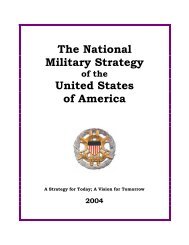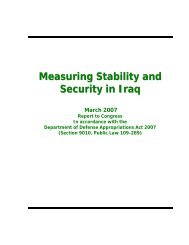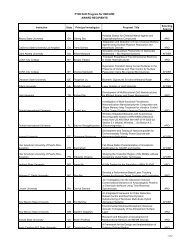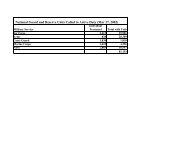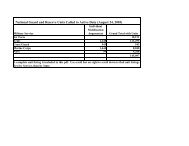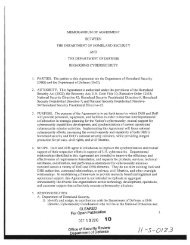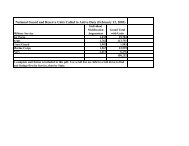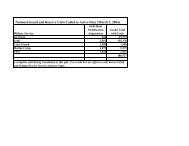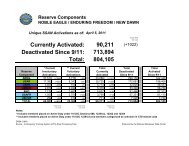Report - United States Department of Defense
Report - United States Department of Defense
Report - United States Department of Defense
Create successful ePaper yourself
Turn your PDF publications into a flip-book with our unique Google optimized e-Paper software.
UNCLASSIFIED<br />
MRRD sub-national programs are focused on district and village levels. The ministry’s two<br />
largest programs, the National Solidarity Program (NSP), which acts in support <strong>of</strong> District<br />
Development Assemblies (DDA) in districts and Community Development Councils (CDCs) in<br />
villages, and the National Area-Based Development Program (NABDP), represent 95 percent <strong>of</strong><br />
MRRD’s program funding. CDCs have expanded to 28,000 villages, an expansion effort that<br />
stalled recently due to security concerns in the remaining uncovered areas.<br />
NPP 3, “Efficient and Effective Governance,” is a three-year, $180M program with the overall<br />
goal <strong>of</strong> strengthening institutional, organizational, administrative, and individual governmental<br />
capacities at central and local levels. NPP 3 was endorsed at the February 2013 JCMB. NPP 4,<br />
“Local Governance,” aims to improve capacity-building at the national and sub-national level,<br />
and seeks to enable the government to carry-out basic government functions, which will facilitate<br />
transition without support from parallel structures. NPP 4 focuses on the following components:<br />
National Basis for Local Governance; Provincial and District Administration; Municipal<br />
Administration; Accountability; and Transparency. These components have specific objectives<br />
that should be achieved through the IDLG portfolio <strong>of</strong> five other Priority Programs. These<br />
programs are dependent upon international funding, a favorable security situation, and adequate<br />
human resources. The five priority programs are:<br />
Strengthening Provincial Administration and Delivery Program (SPAD). The “District<br />
Delivery Program” (DDP) has been run in selected provinces by France, Germany and the<br />
<strong>United</strong> Kingdom (UK) since March 2012, when the USG elected to cease funding it. Recently,<br />
the UK <strong>Department</strong> for International Development (DFID) launched the new SPAD program.<br />
SPAD provides funding to provinces and districts through the Afghan government’s operational<br />
budget. The funding flows through the line ministries. SPAD uses the District and Provincial<br />
Plans, developed by the Director <strong>of</strong> Economy, and continues to use funds from the District<br />
Delivery Program for which DFID has an allotment <strong>of</strong> $32M for three years (2011-2014). For<br />
2012, $9.4M was reserved. The program rolled out to Uruzgan and Bamyan Provinces in<br />
December 2012.<br />
Afghanistan Local Government Facility Development Program (ALGFDP). This is a<br />
construction management project that conducts needs assessments in provinces and districts and,<br />
based on available resources, acquires land and procures and manages construction services<br />
using a standard design and cost schedule for Provincial Governors Offices (PGOs) and District<br />
Governors Offices (DGOs). ALGFDP is funded by UNAMA, USAID, DFID, Denmark, the<br />
Netherlands, and France. The program’s 2012 budget amounts to $17.4M, which is half <strong>of</strong> the<br />
required budget according to the ALGFDP/NPP4 Financial Plan ($33.5M for 2012).<br />
Performance Based Governance Fund (PBGF II). This is an 18-month program (October<br />
2011 – April 2013). According to DFID’s 2012 annual review, the program has met<br />
expectations and helped provincial governors perform to a satisfactory standard. PBGF II’s<br />
budget amounts to $45.5M (<strong>of</strong>f-budget), <strong>of</strong> which two-thirds is USAID-funded ($30.5M). After<br />
contributing $11.5M, the UK ceased financial support in June 2012. The future <strong>of</strong> the program<br />
is uncertain; discussions are ongoing between IDLG, USAID, and DFID on how the program<br />
will continue after USAID funding ends in April 2013. Post-July 2013, DFID wants to continue<br />
its on-budget support in line with NPP 4. For this program to continue successfully, it will need<br />
130



